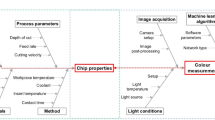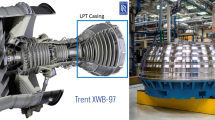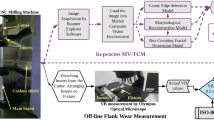Abstract
It was reported that the synergistic effect of process parameters on the superior properties of Inconel 718 exacerbate the wear mechanisms, leading to rapid flank wear rate and unprecedented failure of the PVD-coated carbide inserts during machining. Previous studies employed digital microscopes to identify and measure the dominant wear mechanisms and failure modes as nominal descriptors of flank wear evolution, as well as significant indicators of tool’s remaining useful life and sub-optimal cutting mechanism. However, these methods are time-intensive and involve too much human intervention, which is inefficient for in-process application. Therefore, this study automated the process by leveraging the efficient predictive capability of deep learning architectures to detect the unprecedented failure modes on the tool’s cutting edge as nominal descriptors of rapid flank wear rate, as well as direct indicators of sub-optimal tool performance during machining. To achieve this, an experiment was conducted at various speeds, feeds, and axial depth of cut to characterize the failure modes of PVD-TiAlN/NbN coated carbide inserts during face milling of Inconel 718. The custom imagery dataset, generated from the experimental findings, was pre-processed by labeling the dominant failure modes on the tool’s cutting edge using the MATLAB image labeler application. This created the ground truths for training a custom YOLOv3 tool wear detection model. The trained model was physically validated by conducting another experiment using a new cutting condition to ensure its reliability for real industrial application under unknown cutting conditions. During validation, the model achieved an overall accuracy of 90.86%, with a mean average precision of 0.5659, exhibiting a high efficiency in detecting dominant failure modes, such as notching, built-up edge, flaking, and chipping, on the tool’s flank face.













Similar content being viewed by others
Code availability
Not applicable.
Data Availability
The data used in this manuscript is available from the corresponding author and can be accessed on reasonable request.
References
Liao YS, Lin HM, Wang JH (2008) Behaviors of end milling Inconel 718 superalloy by cemented carbide tools. J Mater Process Technol 201(1–3):460–465. https://doi.org/10.1016/j.jmatprotec.2007.11.176
Dudzinski D, Devillez A, Moufki A, Larrouquère D, Zerrouki V, Vigneau J (2004) A review of developments towards dry and high speed machining of Inconel 718 alloy. Int J Mach Tools Manuf 44(4):439–456. https://doi.org/10.1016/S0890-6955(03)00159-7
Ezugwu EO, Wang ZM, Okeke CI (1999) Tool life and surface integrity when machining inconel 718 with pvd- and cvd-coated tools. Tribol Trans 42(2):353–360. https://doi.org/10.1080/10402009908982228
Banda T, Liu Y, Farid AA, Lim CS (2023) A machine learning model for flank wear prediction in face milling of Inconel 718. Int J Adv Manuf Technol. https://doi.org/10.1007/s00170-023-11152-3
Gao R et al (2015) Cloud-enabled prognosis for manufacturing. CIRP Ann - Manuf Technol 64(2):749–772. https://doi.org/10.1016/j.cirp.2015.05.011
Banda T, Farid AA, Li C, Jauw VL, Lim CS (2022) Application of machine vision for tool condition monitoring and tool performance optimization–a review. Int J Adv Manuf Technol 121(11):7057–7086. https://doi.org/10.1007/s00170-022-09696-x
Thakre AA, Lad AV, Mala K (2019) Measurements of tool wear parameters using machine vision system. https://doi.org/10.1155/2019/1876489
Salimiasl A, Özdemir A (2016) Analyzing the performance of artificial neural network (ANN)-, fuzzy logic (FL)-, and least square (LS)-based models for online tool condition monitoring. Int J Adv Manuf Technol 87(1–4):1145–1158. https://doi.org/10.1007/s00170-016-8548-x
Yuan C, Li G, Kamarthi S, Jin X, Moghaddam M (2022) Trends in intelligent manufacturing research: a keyword co-occurrence network based review. J Intell Manuf 33(2):425–439. https://doi.org/10.1007/s10845-021-01885-x
Zhu K (2022) Machine vision based smart machining system monitoring, pp 267–295. https://doi.org/10.1007/978-3-030-87878-8_8
Wang Y, Dai W, Xiao J (2018) Detection for cutting tool wear based on convolution neural networks. In: Proceedings - 12th International Conference on Reliability, Maintainability, and Safety, ICRMS 2018. Institute of Electrical and Electronics Engineers Inc., pp 297–300. https://doi.org/10.1109/ICRMS.2018.00063
Ozturk T, Talo M, Yildirim EA, Baloglu UB, Yildirim O, Rajendra Acharya U (2020) Automated detection of COVID-19 cases using deep neural networks with X-ray images. Comput Biol Med 121:103792. https://doi.org/10.1016/j.compbiomed.2020.103792
Mamledesai H, Soriano MA, Ahmad R (2020) A qualitative tool condition monitoring framework using convolution neural network and transfer learning. Appl Sci 10(20):1–11. https://doi.org/10.3390/app10207356
Banda T, Jie BYW, Farid AA, Lim CS (2022) Machine vision and convolutional neural networks for tool wear identification and classification, pp 737–747. https://doi.org/10.1007/978-981-33-4597-3_66
Wu X, Liu Y, Zhou X, Mou A (2019) Automatic identification of tool wear based on convolutional neural network in face milling process. Sensors (Switzerland) 19(18). https://doi.org/10.3390/s19183817
Girshick R, Donahue J, Darrell T, Malik J (2016) Region-based convolutional networks for accurate object detection and segmentation. IEEE Trans Pattern Anal Mach Intell 38(1):142–158. https://doi.org/10.1109/TPAMI.2015.2437384
Sun X, Wu P, Hoi SCH (2018) Face detection using deep learning: an improved faster RCNN approach. Neurocomputing 299:42–50. https://doi.org/10.1016/j.neucom.2018.03.030
Girshick R (2015) Fast R-CNN. Proc. IEEE Int Conf Comput Vis, vol. 2015 Inter, pp 1440–1448. https://doi.org/10.1109/ICCV.2015.169.
Ren S, He K, Girshick R, Sun J (2017) Faster R-CNN: towards real-time object detection with region proposal networks. IEEE Trans Pattern Anal Mach Intell 39(6):1137–1149. https://doi.org/10.1109/TPAMI.2016.2577031
Li P, Zhao W (2020) Image fire detection algorithms based on convolutional neural networks. Case Stud Therm Eng 19. https://doi.org/10.1016/j.csite.2020.100625
Redmon J, Divvala S, Girshick R, Farhadi A (2016) You only look once: unified, real-time object detection. In: Proceedings of the IEEE conference on computer vision and pattern recognition, pp 779–788. https://doi.org/10.1109/CVPR.2016.91
Shreyas Dixit KG, Chadaga MG, Savalgimath SS, Ragavendra Rakshith G, Naveen Kumar MR (2019) Evaluation and evolution of object detection techniques YOLO and R-CNN. Int J Recent Technol Eng 8:824–829. https://doi.org/10.35940/ijrte.B1154.0782S319
Redmon J, Farhadi A (2017) Yolo V2.0. Cvpr2017, no. April, pp. 187–213. [Online]. Available: http://www.worldscientific.com/doi/abs/10.1142/9789812771728_0012. Accessed 2 Jan 2023
Shakarami A, Menhaj MB, Mahdavi-Hormat A, Tarrah H (2021) A fast and yet efficient YOLOv3 for blood cell detection. Biomed Signal Process Control 66:102495. https://doi.org/10.1016/j.bspc.2021.102495
Varghese V, Chakradhar D, Ramesh MR (2018) Micro-mechanical characterization and wear performance of TiAlN/NbN PVD coated carbide inserts during End milling of AISI 304 Austenitic Stainless Steel. Mater Today Proc 5(5):12855–12862. https://doi.org/10.1016/j.matpr.2018.02.270
Banda T, Ho KY, Akhavan Farid A, Lim CS (2021) Characterization of tool wear mechanisms and failure modes of TiAlN-NbN coated carbide inserts in face milling of Inconel 718. J Mater Eng Perform 10. https://doi.org/10.1007/s11665-021-06301-2
Banda T, Lestari V, Chuan J, Ali L, Farid A, Seong C (2022) Flank wear prediction using spatial binary properties and artificial neural network in face milling of Inconel 718. Int J Adv Manuf Technol. https://doi.org/10.1007/s00170-022-09039-w
Qiang B et al (2021) SqueezeNet and fusion network-based accurate fast fully convolutional network for hand detection and gesture recognition. IEEE Access 9:77661–77674. https://doi.org/10.1109/ACCESS.2021.3079337
F. N. Iandola, S. Han, M. W. Moskewicz, K. Ashraf, W. J. Dally, and K. Keutzer, “SqueezeNet: AlexNet-level accuracy with 50x fewer parameters and <0.5MB model size,” pp. 1–13, 2016, [Online]. Available: http://arxiv.org/abs/1602.07360
Han S, Mao H, Daily WJ (2016) Deep compression: compressing deep neural networks with pruning, trained quantization and huffman coding. 4th Int Conf Learn Represent. ICLR 2016 - Conf Track Proc. pp 1–14. https://doi.org/10.48550/arXiv.1510.00149
Liu W et al (2016) SSD: single shot multibox detector. Lect Notes Comput Sci (including Subser Lect Notes Artif Intell Lect Notes Bioinformatics) 9905:21–37. https://doi.org/10.1007/978-3-319-46448-0_2/FIGURES/5
J. Redmon and A. Farhadi, “YOLOv3: an incremental improvement,” 2018, [Online]. Available: http://arxiv.org/abs/1804.02767
Wen S, Chen Z, Li C (2018) Vision-based surface inspection system for bearing rollers using convolutional neural networks. Appl Sci 8(12). https://doi.org/10.3390/app8122565
Hossain MB, Iqbal SMHS, Islam MM, Akhtar MN, Sarker IH (2022) Transfer learning with fine-tuned deep CNN ResNet50 model for classifying COVID-19 from chest X-ray images. Informatics Med Unlocked 30:100916. https://doi.org/10.1016/j.imu.2022.100916
A. Bochkovskiy, C.-Y. Wang, and H.-Y. M. Liao, “YOLOv4: optimal speed and accuracy of object detection,” 2020: http://arxiv.org/abs/2004.10934
Iyer B, Rajurkar AM, Gudivada V (2020) Applied computer vision and image processing. In: Advances in Intelligent Systems and Computing. Singapore, Springer Singapore, p 1155. https://doi.org/10.1007/978-981-15-4029-5
Taheri M, Lim N, Lederer J (2016) Balancing statistical and computational precision and applications to penalized linear regression with group sparsity, pp 233–240 http://arxiv.org/abs/1609.07195
Thoma M (2017) Analysis and optimization of convolutional neural network architectures. arXiv:1707.09725. https://doi.org/10.48550/arXiv.1707.09725
Polvorosa R, Suárez A, de Lacalle L et al (2017) Tool wear on nickel alloys with different coolant pressures: comparison of Alloy 718 and Waspaloy. Elsevier https://www.sciencedirect.com/science/article/pii/S1526612517300129, Accessed: Sep. 01, 2020
Chen X, Lv J, Fang Y, Du S (2022) Online detection of surface defects based on improved YOLOV3. In: Sensors 2022, vol 22, p 817. https://doi.org/10.3390/S22030817
Acknowledgements
The authors gratefully acknowledge the financial support from the University of Nottingham Malaysia (UNM), Semenyih, Malaysia, and Malawi University of Business and Applied Sciences (MUBAS), Blantyre, Malawi.
Author information
Authors and Affiliations
Contributions
All authors contributed to the conceptual idea of the manuscript. The first draft of the manuscript was written by Mr. Tiyamike Banda, Ng Hao Wen, and Kevin Choi Wei Xuan. All authors commented on the previous versions. Dr. Veronica Lestari Jauw, Dr. Ali Akhavan Farid and Dr. Chin Seong Lim supervised, reviewed, and edited the manuscript. All authors read and finally approved the final version of the manuscript.
Corresponding author
Ethics declarations
Ethics approval
Not applicable because this article does not contain any studies with human or animal subjects.
Consent to participate
Not applicable.
Consent for publication
Not applicable.
Competing interests
The authors declare no competing interests.
Additional information
Publisher’s note
Springer Nature remains neutral with regard to jurisdictional claims in published maps and institutional affiliations.
Rights and permissions
Springer Nature or its licensor (e.g. a society or other partner) holds exclusive rights to this article under a publishing agreement with the author(s) or other rightsholder(s); author self-archiving of the accepted manuscript version of this article is solely governed by the terms of such publishing agreement and applicable law.
About this article
Cite this article
Banda, T., Jauw, V.L., Farid, A.A. et al. In-process detection of failure modes using YOLOv3-based on-machine vision system in face milling Inconel 718. Int J Adv Manuf Technol 128, 3885–3899 (2023). https://doi.org/10.1007/s00170-023-12168-5
Received:
Accepted:
Published:
Issue Date:
DOI: https://doi.org/10.1007/s00170-023-12168-5




